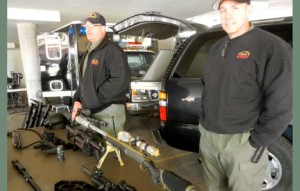DCSO keeps track of bad guys despite cutbacks
By Kathryn Reed
STATELINE – Looking at the tools Douglas County sheriff’s officials have for dealing with bad guys, it’s a wonder anyone challenges them.
A .50-caliber rifle and machine gun are some of the weapons on the table in front of two members of the SWAT team. The crisis negotiation team has a high-tech van to operate out of. The boat patrol is ready for action on the lake. Search and rescue is talking about what it takes to find people.
The men and women and the tools they use in their jobs were incorporated into an open house May 8 outside the sheriff’s substation in Stateline.

Douglas County sheriff’s Capt. Dave Aymami, left, and Sgt. Ron Elges talk about what the SWAT team does. Photos/Kathryn Reed
Kids were able to climb onto the motorcycle as if they were about to take off down Highway 50 to get the speeder. The bomb squad robot, which Tahoe Douglas fire brings out when DCSO needs it, is ready to spring into action.
The goal was to show the community the technology officers have at their disposal, build relationships and explain to residents how crime in the county is being handled. A similar event occurred in the valley last week. The plan is to do this at the lake about every three years.
Sheriff Ron Pierini has seen Douglas County, and Lake Tahoe in particular, change since he started with DCSO in 1976. He was a captain at the Tahoe substation until 1992, then undersheriff and now sheriff.
“The community has changed. Second homes have changed community involvement,” Pierini told Lake Tahoe News.
In the last three years the sheriff’s department’s budget has been cut by $2 million and 10 positions have been eliminated.
Still, the department’s arrest to prosecution rate is 38 percent. Nationwide that average is 22 percent.
Sgt. Ron Elges with the SWAT team said his unit has not been responding to as many calls in the last few years because of the shrinking population.
The three main reasons the SWAT guys are called are for high-risk search warrants, barricaded subjects, and people who have taken off into the woods to avoid capture.
Those barricaded calls also will involve the crisis negotiating team.
“We give them better alternatives than what they’ve chosen,” Deputy Eric Schinzing explained. “Usually it’s domestic issues. Someone thinks about suicide and may have someone with them.”
Pierini said traffic is the No. 1 issue for deputies. He’d like more deputies on the street, but budget constraints prohibit that from happening.
Deputies respond to about 40,000 calls a year. (There are about 50,000 residents in the county.) The 750-square-miles are divided into three areas – Lake Tahoe, Carson Valley and Topaz.
Pierini credits the nonprofit sheriff’s association with keeping the department flush with the necessary tools. He said that group has spent about $600,000 in the last seven years on equipment.
A cadre of volunteers also helps the sheriff’s department. Between search and rescue, boat patrol and citizens patrol about 300 people volunteer with DCSO.
“If you added up the hours the volunteers put in, it would be a huge amount of money to have to replace them with paid staff,” Pierini said. He said some people put in 200 hours a year. “We couldn’t function at the level we do today without them.”



